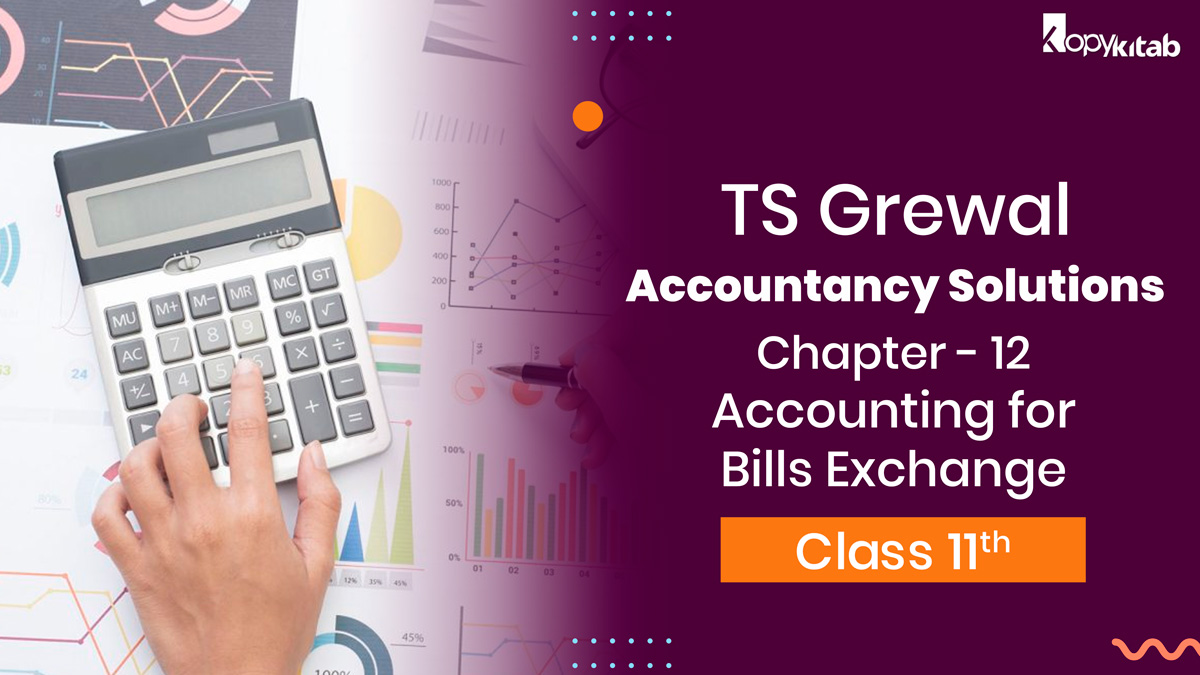
TS Grewal Class 11 Accountancy Solutions Chapter 12: One of the most important topics in Class 11th Accountancy is Chapter 12 – Accounting for Bills Exchange and TS Grewal Class 11 Accountancy Solutions has made it easier for the students. The exchange of bills is the chapter of numerical and preparing bills is an important concept. Chapter 12 alone consists of around 44 questions, which are solved in a step-by-step way.
- Read More: TS Grewal Class 11 Solutions
TS Grewal Class 11 Accountancy Solutions Chapter 12 – Accounting for Bills Exchange | Download Free PDF
TS Grewal Class 11 Accountancy Solutions Chapter 12
Detailed Explanation for Chapter 12 – Accounting for Bills Exchange, TS Grewal Class 11 Accountancy Solutions
Meaning of a bill exchange
TS Grewal Class 11 Accountancy Solutions begins the explanation of Chapter 12 by answering the first and basic question, i.e., the meaning of a bill exchange.
So, a bill exchange is explained as a written order used by trade and other multinational companies or firms for doing business on international grounds. This bill makes one party bound to pay a fixed amount of money to another party on their demand or an already decided date.
Students might think of bills of exchange and cheques as something different from each other. But TS Grewal Class 11 Accountancy Solutions mentions no big difference between them. Instead, they are quite similar as both of them can be quickly drawn by an individual or bank and both of them are transferable by endorsement.
Types of bills exchange
- Bank draft: A bank draft is a kind of bill exchange issued to a payee by the bank. This exchange shows the banks taking guarantees of the payments done in the transactions.
- Sight draft: This is the type of bill exchange where funds need to be paid on an immediate basis or on-demand.
-
Trade draft: If the bills’ exchange is taken by an individual, then it is a trade draft.
Points to remember
- A bill exchange can happen when there is an involvement of 3 parties:
- First is the drawee, party that pays the amount.
- Second is the payee, the receiver of the money paid by the drawee.
- The third is the drawer, who obliges the drawee to pay to a payee.
- The main use of bill exchange is for making international trade and helping exporters and importers complete their transactions quickly and successfully.
- Although this bill is not a contract, the parties involved in the exchange can draw terms of transactions, like rate of accrued interest and credit terms.
TS Grewal Class 11 Accountancy Solutions Chapter 12 – Accounting for Bills Exchange: Sample Questions
Sample question 1:
Calculate the due date of the following cases mentioned below:
|
Date of bill |
Tenure |
|
December 1, 2017 |
60 days |
|
April 30, 2018 |
2 months |
|
Jan 28, 2018 |
1 month |
|
Nov 23, 2017 |
2 months |
|
May 29, 2017 |
4 months |
Answer:
|
Date of bill |
Period |
Calculation |
Due date |
|
December 1, 2017 |
60 days |
30 Dec, 2017+ 30 Jan, 2017+ 3 days of grace |
Feb 2nd, 2018 |
|
April 30, 2018 |
2 months |
2 months from 30 April 2018 would be 30 June 2018 + 3 days of grace |
July 3rd, 2018 |
|
Jan 28, 2018 |
1 month |
1 month from 28 Jan 2018 would be 28 Feb 2018 + 3 days of grace. |
March 3rd, 2018 |
|
Nov 23, 2017 |
2 months |
2 months from 23 Nov 2017 would be 23 Jan 2018 + 3 days of grace. |
Jan 26th, 2018, national holiday, the due date would be Jan 25th, 2018. |
|
May 29, 2017 |
4 months |
4 months from 29 May 2017 would be 29 Sept 2017 + 3 days of grace. |
Oct 2nd, 2017, national holiday, the due date would be Oct 1st, 2017 |
We have included complete information regarding CBSE TS Grewal Class 11 Accountancy Solutions Chapter 12 – Accounting for Bills Exchange. If you have any queries regarding the Class 11 Accountancy exam, you can ask in the comment box.
FAQs: TS Grewal Class 11 Accountancy Solutions Chapter 12 – Accounting for Bills Exchange
What is a bill exchange? Define it.
A bill exchange is explained as a written order used by trade and other multinational companies or firms for doing business on international grounds. This bill makes one party bound to pay a fixed amount of money to another party on their demand or on an already decided date.
What is a bank draft?
A bank draft is a kind of bill exchange issued to a payee by the bank. This exchange shows the banks taking a guarantee of the payments done in the transactions.
How many parties are involved in a bill exchange?
A bill exchange can happen when there is an involvement of 3 parties:
1. First is the drawee, party that pays the amount.
2. Second is the payee, receiver of the money paid by the drawee.3.
3. Third is the drawer, who obliges the drawee to pay to a payee.
Can I download TS Grewal Class 11 Accountancy Solutions Chapter 12 – Accounting for Bills Exchange free PDF?
Yes, you can download TS Grewal Class 11 Accountancy Solutions Chapter 12 – Accounting for Bills Exchange free PDF.
